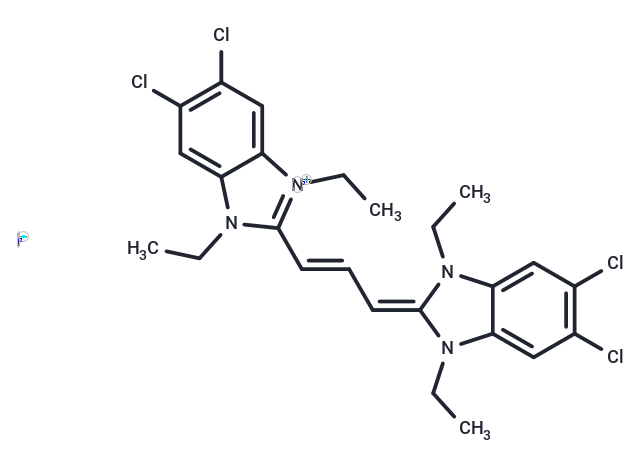Shopping Cart
Remove All Your shopping cart is currently empty
Your shopping cart is currently empty
JC-1 (CBIC2) is a fluorescent lipophilic carbonyl cyanine dye. JC-1 is used to measure mitochondrial membrane potential. When the mitochondrial membrane potential is relatively high, JC-1 converges in the matrix to form a polymer, which can produce red fluorescence (λex=585 nm, λem=590 nm). When the mitochondrial membrane potential is low, JC-1 cannot accumulate in the mitochondrial matrix and exists in the form of monomers to produce green fluorescence (λex=510 nm, λem=527 nm).

| Pack Size | Price | USA Warehouse | Global Warehouse | Quantity |
|---|---|---|---|---|
| 1 mg | $59 | In Stock | In Stock | |
| 2 mg | $81 | In Stock | In Stock | |
| 5 mg | $153 | In Stock | In Stock | |
| 10 mg | $252 | In Stock | In Stock | |
| 25 mg | $423 | In Stock | In Stock | |
| 50 mg | $628 | In Stock | In Stock | |
| 100 mg | $893 | - | In Stock |
| Description | JC-1 (CBIC2) is a fluorescent lipophilic carbonyl cyanine dye. JC-1 is used to measure mitochondrial membrane potential. When the mitochondrial membrane potential is relatively high, JC-1 converges in the matrix to form a polymer, which can produce red fluorescence (λex=585 nm, λem=590 nm). When the mitochondrial membrane potential is low, JC-1 cannot accumulate in the mitochondrial matrix and exists in the form of monomers to produce green fluorescence (λex=510 nm, λem=527 nm). |
| Targets&IC50 | α-synuclein:2.6 μM (Kd) |
| In vitro | JC-1 fluorescence is usually excited by the 488nm laser wavelength common in flow cytometers[1]. JC-1 (2.5μM) exposed to murine L1210 lymphoblasts, can be detected the presence of both cytoplasmic JC-1 monomer and mitochondrial J-aggregates in these cells. Fluorescent labeling of mitochondria with either JC-1 (1 μg/mL, 15 min), reveals that are distributed irregularly, resulting in regions of high and low mitochondrial content within astrocytes[2]. JC-1 is avidly accumulated in sensitive K562 cells where it displays both a green cytoplasmic and red mitochondrial fluorescence. JC-1 is poorly accumulated in resistant K562 cells, which displays only a slight green fluorescence[4]. JC-1 has been shown to interact with α-synuclein at the acidic C-terminal region with a Kd of 2.6 μM. JC-1 itself does not accelerate the protein aggregation of α-synuclein in the absence of iron, insted, it decelerates the aggregation process by extending the lag phase approx[3]. |
| Cell Research | Instructions I. Solution preparation 1. Stock solution preparation: JC-1 is dissolved in DMSO to prepare a stock solution. The concentration of the stock solution is usually 5 mg/ml. Please refer to the manufacturer's instructions for the specific concentration. 2. Working concentration: The working concentration of JC-1 is usually 1-20 µg/ml, but the optimal concentration may need to be optimized depending on the cell type and experimental conditions. 3. Dilution: Dilute the stock solution with cell culture medium or appropriate buffer before use. II. Staining cells 1. Cell preparation: Culture the cells to be tested under appropriate conditions (e.g., 37°C, 5% CO₂). 2. Incubation with JC-1: Add the diluted JC-1 working solution to the cells. Depending on the cell type and experimental conditions, incubate for 15-30 minutes. 3. Washing: After incubation, wash the cells 1-2 times with preheated cell culture medium or PBS to remove excess dye. 3. Fluorescence detection 1. Fluorescence microscopy: Use a fluorescence microscope equipped with appropriate filters to detect green (monomer JC-1) and red (aggregate JC-1) fluorescence. The excitation wavelength of green fluorescence is usually 485-490 nm, and that of red fluorescence is 525-530 nm, with emission peaks at 535 nm (green) and 590 nm (red), respectively. 2. Flow cytometry: Flow cytometry can also be used for quantitative analysis. Use appropriate filters (e.g., 525/40 nm for green fluorescence and 585/42 nm for red fluorescence) for detection. 3. Data interpretation: An increase in red fluorescence indicates a higher mitochondrial membrane potential, while an increase in green fluorescence indicates a loss or decrease in membrane potential. |
| Synonyms | CBIC2 |
| Molecular Weight | 652.23 |
| Formula | C25H27Cl4IN4 |
| Cas No. | 3520-43-2 |
| Smiles | [I-].CCN1C(=C\C=C\c2n(CC)c3cc(Cl)c(Cl)cc3[n+]2CC)N(CC)c2cc(Cl)c(Cl)cc12 |
| Relative Density. | no data available |
| Color | Purple |
| Appearance | Solid |
| Storage | keep away from direct sunlight,store at low temperature | Powder: -20°C for 3 years | In solvent: -80°C for 1 year | Shipping with blue ice/Shipping at ambient temperature. | |||||||||||||||||||||||||
| Solubility Information | DMSO: 14 mg/mL (21.46 mM), Sonication is recommended. | |||||||||||||||||||||||||
Solution Preparation Table | ||||||||||||||||||||||||||
DMSO
| ||||||||||||||||||||||||||
| Size | Quantity | Unit Price | Amount | Operation |
|---|

Copyright © 2015-2025 TargetMol Chemicals Inc. All Rights Reserved.